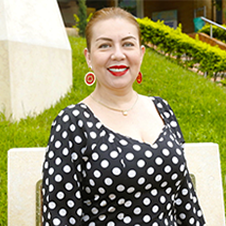Chief Editor
Claudia Consuelo Torres Contreras, RN, MSc, PhD (c) Nursing Program, University of Santander-UDES, Colombia.

Cuidarte Journal Editor-in-Chief
PROFILE AND FUNCTIONS
The Editor-In-Chief reports to the Editorial Board of the institution, recommends and takes actions to increase the distribution and impact of the scientific journal, supervises subordinated editors and associated personnel, and supports the scientific journal. The Editor-In-Chief has a responsibility towards the authors providing journal content, the peer reviewers commenting on the suitability of manuscripts for publication, the journal readers and scientific community in general, the journal’s publishing institution, personnel and public at large.
PROFILE AND FUNCTIONS
Having a general scientific knowledge of the fields within the scope of the journal and having proven skills in scientific writing and editing, science evaluation, negotiation, and diplomacy.
- Publishing original, relevant, methodologically correct, well-documented articles reviewed by anonymous peer reviewers within the scope of scientific topics of interest to journal readers.
- Publishing the journal in a timely manner, preferably in a continuous publication model.
- Establishing and updating editorial policies for: Manuscript submission, instructions for authors and ethical principles for publication. Time standards for each stage of the editorial process and quality control to be applied at the different stages of the editorial process. Process of peer review, editorial evaluation, and decision, in addition to methods for reconsideration of rejected manuscripts. Identification and selection of topics for future calls and special issues. Determination of conflict of interest and intellectual property. Resolution of ethical issues such as complaints and results of scientific misconduct or malpractices.
- Providing updates on publishing policies and guidelines (e.g. instructions for authors, reviewer guidelines, ethical guidelines, reports, etc.) to the Publishing Board of the institution.
- Providing reports to the Publishing Board of the institution, making requests and formulating action plans with journal indexing strategies.
- Assuring maximum visibility of the journal, ensuring its indexing in institutional and International repositories. Proposing the journal to international indexing and full-text content systems.
- Ensuring that the journal IT support allows a safe and stable operation following proper response times, as well as implementing backup and digital preservation policies.
- Chairing Editorial Board meetings (associate editors, editorial committee, scientific committee, executive committee, and support staff.).
- Receiving and responding to complaints from those involved in the publishing process.
- Planning and implementing the journal’s annual budget in accordance with the Publishing Board of the institution.
- Representing the Editorial Board in negotiations with departments of the publishing institution, ad hoc government and international bodies, as well as with the scientific editorial community.
EDITORIAL FREEDOM: The Editor-In-Chief shall have full authority to determine journal contents in every aspect of the scientific content to be published.
EDITOR’S TERM: The Editors-In-Chief are appointed by the Publishing Committee of the institution for a specific number of years, which can be renewed at the discretion of the Committee.
EDITORIAL ETHICS: Editors’ code of conduct will be determined by the recommendations of the Council of Science Editor, especially by the White Paper on Publication Ethics.


